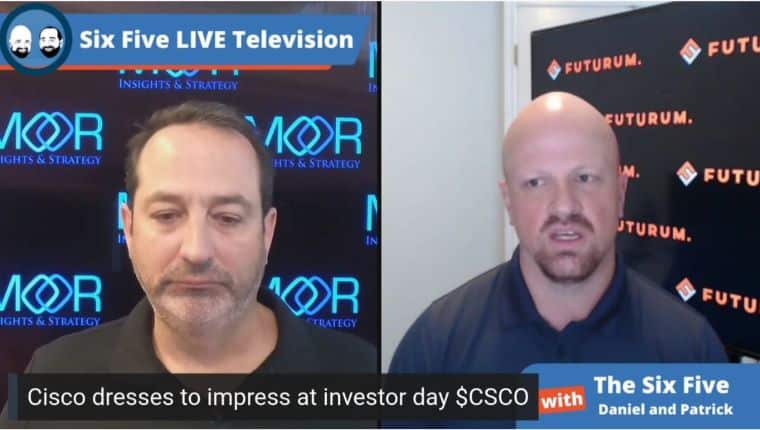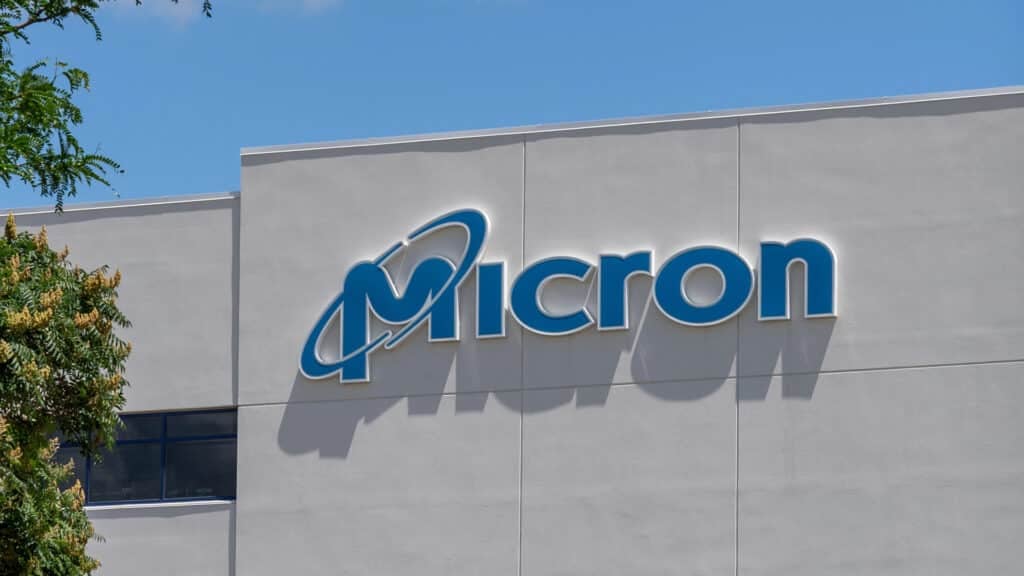The Six Five team dives into the Cisco Investor and Tech Industry Analyst Conferences.
Watch the clip here:
If you are interested in watching the full episode you can check it out here.
Disclaimer: The Six Five Webcast is for information and entertainment purposes only. Over the course of this webcast, we may talk about companies that are publicly traded and we may even reference that fact and their equity share price, but please do not take anything that we say as a recommendation about what you should do with your investment dollars. We are not investment advisors and we do not ask that you treat us as such.
Transcript:
Daniel Newman: You want to talk about Cisco investor day?
Patrick Moorhead: Let’s do it.
Daniel Newman: Yeah, so this week Cisco had an investor day and an analyst summit. Pat, you and I attended, spent many hours in various meetings and had a lot of access. So it was really great. Chuck Robbins, CEO, Scott Harrell, the CFO. We had listened to Tony, the head of strategy and they were very engaged and answering our questions, but let’s talk about what, at least my takeaways were for the company.
So we have a very large, one of the world’s most trusted technology company leaders. We’ve heard no one ever got fired for buying Cisco. You can replace that with a few other names, but that is one of the old outages. Chuck basically at a very high level, kicked off wanting to people to kind of reminder to the world because we like to talk about Amazon and Microsoft.
We like to talk about the big chip company. Sometimes some of these big stable enterprise B2B technology companies have become a little bit undercover, is what I would say, in the press, in the media, Cisco deserves a little more attention. He pointed out it’s an ecosystem of more than a million customers and partners, Pat. 98% of the Fortune 500, company is in an innovator. They have 25,000 patents and they spend $6.5 billion a year on R&D.
And Pat, we talk a lot about that. R and/or D, best place in the world of work. But what the whole theme of this event was really about in my opinion, was Cisco trying to convince the investor community and then later the analyst and the industry analyst community, that they are ready and prepared to make a pivot away from big iron halfbacks, perpetual licensing models and maintenance agreements to a subscription-based, everything in the portfolio as a service.
Now I’m going to give you two sides. One, absolutely necessary, as our friend John Ford would say. On the other hand, Cisco is doing pretty much exactly what every other company in their situation are doing. We heard Antonio Neri in 2019, pretty much make this proclamation albeit smaller companies, smaller portfolio, easier maybe to make that move than would be for Cisco.
Lenovo is in this transformation right now, Pat. We’ve heard Michael Dell and Jeff Clark talk about this transformation. So it’s not necessarily unique, but whether it’s unique or not, convincing the market that they’re able to do this and they’re going to be successful was one of the big outcomes of this investor day.
So he focused on growth of software revenue, growth of subscription revenue, growth of services revenue. How quickly is the company transforming to software? We’re seeing over about a six year period of time that companies improve its subscription revenues by about 23%, is how much it’s moved for that category.
We’re seeing how much are they innovating? What were they doing in 2017 versus 2021? And this was the kind of stuff that Chuck really focused on. And then of course, really trying to make sure that the market understood that they are attached to cloud growth. So while we think of AWS, we think of Azure, we think of Oracle cloud. We can talk about that in a minute.
We think of Google. People haven’t necessarily figured out how to think about Cisco when they think about cloud. You obviously have the scale out scale up part of their optical, of their internet, of the future technologies that come from that side of the business. So people don’t realize that Cisco’s in the chip space.
Cisco has a business there and they are outfitting connectivity for a number of cloud scale players. On the other side, you’ve got their data center network and infrastructure. Well, all this hybrid cloud needs the on-prem and it needs to be super fast and connected. Cisco has the Edge.
So all the hardware, all the connectivity, whether that’s Edge branch campus, or Edge servers and connectivity, for things like smart cities and connected devices and retail, the company is playing in that space too. So I think we could cover a lot of ground and I do in fairness, want to give you some room, but what I really felt here, CEO Chuck Robbins leaned into the fact that the company is prepared to make this transformation.
They’re still very focused on security. They’re still very focused on building the highest quality hardware. They’re focused on helping to deliver technologies that cloud scale companies can embrace, but they’re also focused on moving to consumption. They’re focused on subscription growth. They’re focused on being more as a service, being valued more as a software company.
And I think as a whole, that came very clear. They will be competing with everyone else to do this exact same thing. And I think the commitment that they’re making will be validated through their growth, which they’re targeting at five to 7%.
Hard to necessarily get super excited about that, but if they can make this transformation move to that kind of revenue and continue growing in a five to 7% rate while doing that, I think the market will be fairly satiated. Because growth while moving to consumption is sometimes, as we’ve seen Pat, very hard to come by.
Patrick Moorhead: Yeah. So Daniel, that was great analysis. One thing I want to flash up, and this was my favorite slide from the entire day because it pretty clearly shows to me that falling out of bed and not stretching a bit, we’re looking at a $400 billion TAM for Cisco. But essentially, part of this the talk track is how do they monetize the public cloud?
And that was key for me. I mean, listen, I’m certainly not a hybrid cloud denier. 10 years ago, my analyst firm cited it as the most important growing thing. I got into OpenStack, which ended up being a disaster. But with Kubernetes and things like that, it’s a whole different thing. So Cisco’s cloud capability is hybrid, but it’s also public.
Like you said with Silicon One chips and that’s in that internet of the future. But what some people don’t realize is that for cloud expansion, you need internet expansion. And with internet expansion, you need Cisco equipment. So that’s one. The other thing Cisco doesn’t get enough credit for is that it has what is called full stack observability.
So today’s applications, whether it’s a smartphone app have multiple APIs, multiple levels, potentially data being in multiple places. And you have to know exactly what’s going on in every step of that. And by the way, most of that capability is in the public cloud. You need a service to tell you what’s going on.
So if something breaks, you can go fix it. And my gosh, if you’re a financial institution, you actually get ranked and rated and can be fined if your performance and availability isn’t at a certain level. And that’s where things like AppDynamics and ThousandEyes can come in and help. Security as well, right? Security is end-to-end, it’s private cloud.
It’s hybrid cloud. So that was my biggest learning of the day. And while I’ll admit, I don’t completely understand the 900 billion which is adjacent. I like to focus on this one because the $400 billion to me is one that is easy to understand. It’s funny, I’m wondering on this Daniel, future of work was already covered in the 400 billion here, right?
See hybrid work. I’m wondering, does this pretend to acquisitions maybe, or them getting into something that is beyond something that they’re doing today?
Daniel Newman: It was a little unclear. This will be something that will be great in our conversation that I’m sure we’ll get with either with Scott or Chuck or Liz in the near future. I’d love to ask that question. In fact, now that you’re asking that question, I wish I’d asked that question.
I think what they’re really kind of saying, and this is something I keep saying is that we like to talk about the competition for market share as if markets are flat, but markets are growing. And so obviously we are addressing the fact that, this goes back to what we talked about with Zoom and Poly, Pat, just like the way work is shifting.
Whether that’s NLP technologies that enable people to communicate across different languages within an application concurrently. There’s all kinds of different adjacent technologies required to make that happen. I don’t know exactly what Cisco’s plan is to participate in that, but we know WebEx, for instance, opens a lot of doors.
Maybe they’re going to launch a productivity suite. I mean, who knows? But we’ve got to keep moving here, Pat. Good topic, we’ll come back to that one everybody. It was great to actually have that much time to hear of Cisco’s plan to move forward.
Author Information
Daniel is the CEO of The Futurum Group. Living his life at the intersection of people and technology, Daniel works with the world’s largest technology brands exploring Digital Transformation and how it is influencing the enterprise.
From the leading edge of AI to global technology policy, Daniel makes the connections between business, people and tech that are required for companies to benefit most from their technology investments. Daniel is a top 5 globally ranked industry analyst and his ideas are regularly cited or shared in television appearances by CNBC, Bloomberg, Wall Street Journal and hundreds of other sites around the world.
A 7x Best-Selling Author including his most recent book “Human/Machine.” Daniel is also a Forbes and MarketWatch (Dow Jones) contributor.
An MBA and Former Graduate Adjunct Faculty, Daniel is an Austin Texas transplant after 40 years in Chicago. His speaking takes him around the world each year as he shares his vision of the role technology will play in our future.





